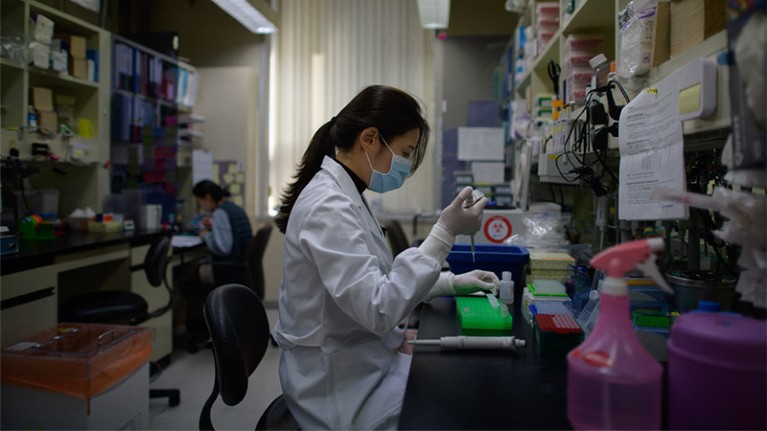
Early-career scientists in South Korea are worried about cuts to the research budget.Credit: Ed Jones/AFP via Getty
News of a large cut to South Korea’s research and development (R&D) budget has stirred a strong reaction from the nation’s scientists. The 14.7% cut — which was reduced from 16.6% in late December, in response to widespread negative feedback — is set to make life more difficult for researchers across the board. Early-career scientists are likely to be the most affected, because we are already struggling with a lack of funding and job security.
The initial cut was announced by South Korea’s Ministry of Science and ICT (MSIT) just months after President Yoon Suk Yeol stated that R&D spending would remain at 5% of the country’s gross domestic product (GDP), which is among the highest R&D investments in the world. This aligns with the generally accepted belief among South Koreans that, for a country with limited land and natural resources, the only way to become richer and stronger is through advances in science and technology. Many researchers take pride in feeling that they have been a driving force behind South Korea’s rapid economic development since the 1960s.
This shift in government priorities has undoubtedly been prompted by South Korea’s need to address fiscal challenges in the past few years. However, we feel that it overlooks the crucial role of R&D investment not only in the country’s immediate research outcomes, but also in nurturing future generations of professionals in science, engineering, mathematics and technology.
Boosting South Korea’s basic research
Universities will be hit hard. It’s no secret that many South Korean universities are fighting for survival, owing to a sharp decrease in student enrolment. The number of 18-year-olds in South Korea decreased from 706,000 in 2011 to 443,000 in 2023, which is below the total admission capacity of the country’s universities. Some institutions are taking radical actions to attract more students, such as by ‘restructuring’ departments under the pretext of efficiency and relevance.
Many basic-science units, for example, have been transitioned into more industry-focused areas, including artificial intelligence and semiconductor research. In 2013, there were 54 physics departments in South Korea’s 188 universities. By 2022, this number had fallen to 45, and more units are expected to be shut down or transitioned away from basic research. If current trends continue, faculty jobs in basic research will disappear.
In addition to the decrease in the number of young people, a 15-year government-mandated freeze on university tuition-fee increases remains in place amid the steady growth in cost of living and salaries. Faculty members are being asked to teach extra courses to reduce staffing costs, which is burdening early-career researchers, who are trying to establish their reputation by publishing high-quality papers but are instead having to devote extra time to teaching.
Threat to basic research
Some details have been released about the upcoming budget cuts. In 25 government-funded institutes, a 25.2% cut is planned for this year. We fear that this will result in the reduction of places for young researchers and students, to account for existing expenditures. Some major institutes of science and technology are expecting a budget cut of around 10%, which has raised concern among graduate students. Student unions at major universities across South Korea issued a strong statement condemning the cuts.
Big changes are also expected for the National Research Foundation of Korea (NRF), the country’s main funding agency and a major investor in basic research. This year, funding will be cut for some existing basic-research projects, as will opportunities for early-career researchers to start new projects. As early-career scientists running NRF-funded projects, we have already had to make difficult decisions because of budget cuts, such as putting recruitment on hold or cancelling equipment orders.
South Korean scientists’ outcry over planned R&D budget cuts
The ministry says that part of its rationale for the cuts is to shift funds towards early-career researchers, but its unpredictable policies are sewing confusion in this group. This year, for example, the NRF increased the maximum grant amount for new proposals under its ‘outstanding young scientist grants’ scheme, but also cut funding to ongoing projects by 10%. These moves seem contradictory and could undermine the stability and continuity of research efforts.
Lessons can be learnt from our neighbour, Japan, whose contribution to world-class research has been in decline over the past decade, despite the nation ranking third globally — after China and the United States — in the total number of researchers. Limiting the amount of funding and time that researchers can spend on actual research by overloading them with teaching, industry collaboration and community-engagement commitments to keep staffing costs down is a key factor in Japan’s slide in scientific performance, as reported by Nature in October. This is exactly what South Korea is facing.
The solution is clear, and the same for South Korea and Japan: support early-career researchers. They are the key to near-term success in science and innovation, and will inspire generations into the future. South Korea has the lowest birth rate in the word, and its achievements in science look fragile. Before the decline begins, we need to show young researchers that there is hope for the future.

 South Korean scientists’ outcry over planned R&D budget cuts
South Korean scientists’ outcry over planned R&D budget cuts
 The open secret that underpins South Korea’s science success
The open secret that underpins South Korea’s science success
 Boosting South Korea’s basic research
Boosting South Korea’s basic research
 How South Korea made itself a global innovation leader
How South Korea made itself a global innovation leader
 South Korean institutions lure global talent
South Korean institutions lure global talent





